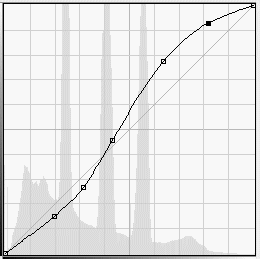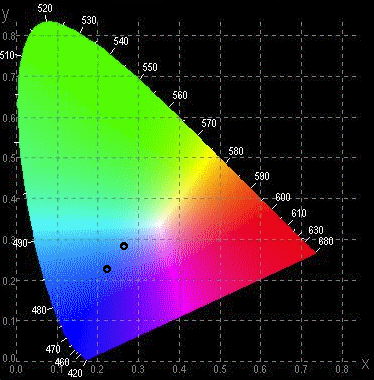Doug Kerr
Well-known member
In another thread, Mike Spinak gave a link to a video from Unified Color discussing their own color space, "Beyond RGB" (gag me with a spoon), used in their HDR processing software.
It mentions a problem with "color shift" when applying tone remapping curves in the sRGB color space, and how that can become very troublesome in HDR processing..
I suspect they are speaking of chromaticity shift (we of course must shift colors when we do any remapping). (In their entire presentation, they call chromaticity "color".)
I thought I'd discuss one such phenomenon, not in the context of HDR processing, but in something perhaps more familiar.
Here we see a tonal remapping curve we might set up in Photoshop. It is set up to affect all three color "channels".

Imagine that in our starting image we had a small region whose RGB coordinates were 50, 80, 110.
When we then invoke the curve shown, its coordinates then become 38, 68, 116.
The chromaticity of the region (with its original coordinates) on the CIE x-y chromaticity diagram (the graphic presentation we most commonly see for chromaticity) is x=0.26, y=0.28.
We can see that here:
After the "S-curve" has been applied, the chromaticity of the region is x=0.23, y=0.23. That means it is visually "more blue" than it was before.

We might wonder why this is. Is it not so that if we have a color with certain coordinates and change them all proportionately, the chromaticity remains unchanged?
Quite so. (Almost exactly.)
But in our example, the initial values of the three coordinates fall at different points on the curve (at the horizontal values of the three little dots shown in the lower-left portion of the chart, in fact). Because the curve is non-linear, the new values of the three coordinates (the vertical values on the curve) do not change proportionally.
By the way, how could we avert this particular phenomenon? A direct way would be to use a luminance-chromaticity color space, and then doing general-purpose tone remapping on the luminance channel only.
Do we ever use such a color space? No.
Isn't L*a*b* a luminance-chromaticity color space? No. It is a pseudo-luminance, pseudo-chrominance color space. If we change L*, and leave a* and b* alone, the chromaticity does not remain constant (although it more nearly does than when working with RGB). (The pseudo-chrominance does remain constant.)
How does the color space used by Unified Color work, and how does that avert (or mitigate) this phenomenon? Beats me.
Best regards,
Doug
It mentions a problem with "color shift" when applying tone remapping curves in the sRGB color space, and how that can become very troublesome in HDR processing..
I suspect they are speaking of chromaticity shift (we of course must shift colors when we do any remapping). (In their entire presentation, they call chromaticity "color".)
I thought I'd discuss one such phenomenon, not in the context of HDR processing, but in something perhaps more familiar.
Here we see a tonal remapping curve we might set up in Photoshop. It is set up to affect all three color "channels".

Imagine that in our starting image we had a small region whose RGB coordinates were 50, 80, 110.
When we then invoke the curve shown, its coordinates then become 38, 68, 116.
The chromaticity of the region (with its original coordinates) on the CIE x-y chromaticity diagram (the graphic presentation we most commonly see for chromaticity) is x=0.26, y=0.28.
We can see that here:
After the "S-curve" has been applied, the chromaticity of the region is x=0.23, y=0.23. That means it is visually "more blue" than it was before.

We might wonder why this is. Is it not so that if we have a color with certain coordinates and change them all proportionately, the chromaticity remains unchanged?
Quite so. (Almost exactly.)
But in our example, the initial values of the three coordinates fall at different points on the curve (at the horizontal values of the three little dots shown in the lower-left portion of the chart, in fact). Because the curve is non-linear, the new values of the three coordinates (the vertical values on the curve) do not change proportionally.
By the way, how could we avert this particular phenomenon? A direct way would be to use a luminance-chromaticity color space, and then doing general-purpose tone remapping on the luminance channel only.
Do we ever use such a color space? No.
Isn't L*a*b* a luminance-chromaticity color space? No. It is a pseudo-luminance, pseudo-chrominance color space. If we change L*, and leave a* and b* alone, the chromaticity does not remain constant (although it more nearly does than when working with RGB). (The pseudo-chrominance does remain constant.)
How does the color space used by Unified Color work, and how does that avert (or mitigate) this phenomenon? Beats me.
Best regards,
Doug
